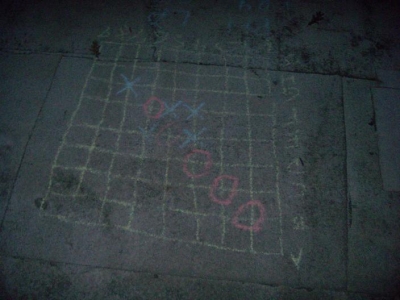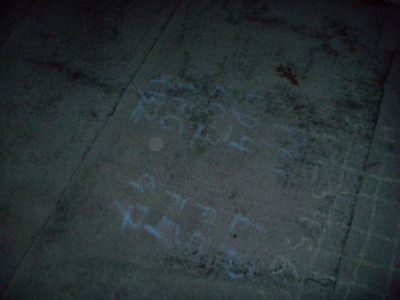Public Surface by teucer, Levitating Potato
March 23rd, 2008 12:17 PMThe basic idea was to come up with a game of incomplete information that could nonetheless be played on paper. It was largely based on Gomoku, but with hidden moves. It's taken a while to get our completion up because we've tinkered with the rules a bit since then to make a far better game. The result:
HIDDEN MOVE DOUBLE GOMOKU.
The rules:
The object of the game is to be the first to make two rows of five pieces, while stopping your opponent from doing the same. However, matters are complicated by the fact that you don't know where all of your opponent's pieces are, and blocking his moves requires you to reveal some of yours.
This game is played on a nine-by-nine goban (go board) with stones as markers, or with x's and o's on the intersections of a nine-line by nine-line grid drawn on paper (recommended) or some other surface. The rows of the grid should be lettered, and the columns numbered, or vice versa. (We used letters A-H and J, as this is how go boards are presumed to be marked for recording of games.)
In addition to the board, you need one paper or other writing surface for each player, and a writing implement for each player's use. These rules will assume you're using x's and o's; read black and white stones instead if you are using a physical board.
To begin, one player places an x on the board. The other player then chooses whether to be x or o. X starts with that piece already in place, but o moves first. From then on, each turn consists of the following sequence of events, which may sound complicated but in practice plays quite smoothly:
1. The player whose turn it is writes down a board position where they intend to move.
2. That player announces either the row or the column they have written, but not both.
3. The other player has the option of revealing any number of previously-recorded moves in that same row or column.
4. If their opponent has chosen to reveal any previous moves, the player whose turn it is must reveal where they had placed the piece. If any of the pieces revealed by their opponent was in that same spot, the move fails; otherwise, it succeeds. (Yes, it is possible for a piece to be successfully placed where the opponent already has a piece but chooses not to reveal it, leaving two pieces in that spot at the end of the game.)
5. All revealed pieces should be marked on the board for everyone to see. No future pieces may be played on those spots.
6. If placing the piece causes a sequence of five pieces to be formed for the first time, the player who has done so must announce it.
A player wins when they have made two lines, orthogonal or diagonal, of five pieces in a row. The two lines must share no more than a single piece (so no, six in a row doesn't count as victory - though nine in a row would, if you pull it off).
It is recommended that you use your private writing area to record what your opponent has announced as well as your own moves; this will help you avoid having your own moves thwarted. There's an example of play in the files below, which can be consulted for clarification of how to play.
A game

An earlier version of the game, where only one five-in-a-row was required. This version was of lower quality. O won.
Record of moves

Moves being recorded; this is the hand-drawn version of the ods file (though from a different game).
Sample game
Dr. Harmon's record of a sample game played via AIM. All of Dr. H's moves are on the board, as are all of LP's moves that he knows about. It also contains a record of the moves announced.
Sample of gameplay
This is the same game as the sample board in the ODS file, as it happened over AIM. The screen names have been changed. Here are all the move declarations that led to the sample game in the spreadsheet.
5 vote(s)
Terms
(none yet)5 comment(s)
Nah, I still don´t get it, but I don´t get backgammon either...
So, you played it with chalk on the roof of the Mc Donalds?
Yes, we did. It's not quite public, but it is certainly awesome.
If there's anything you don't understand about the rules, we're happy to try to explain it better.
And if anybody ever wants to play me sometime, I'm game anytime we meed in person. (Journey Chicago, anybody?)
If it helps, visualize some sort of mutant cross between battleship and gomoku.
Yeah, I´m getting there, the transcript helped a lot :)
















.jpg)


























I have to reread this one when fully caffeinated, but I´m amazed enough with the way you guys are landing such an elegant collaborative sequence of actions. The kind of game that can endanger one´s sanity, it seems.